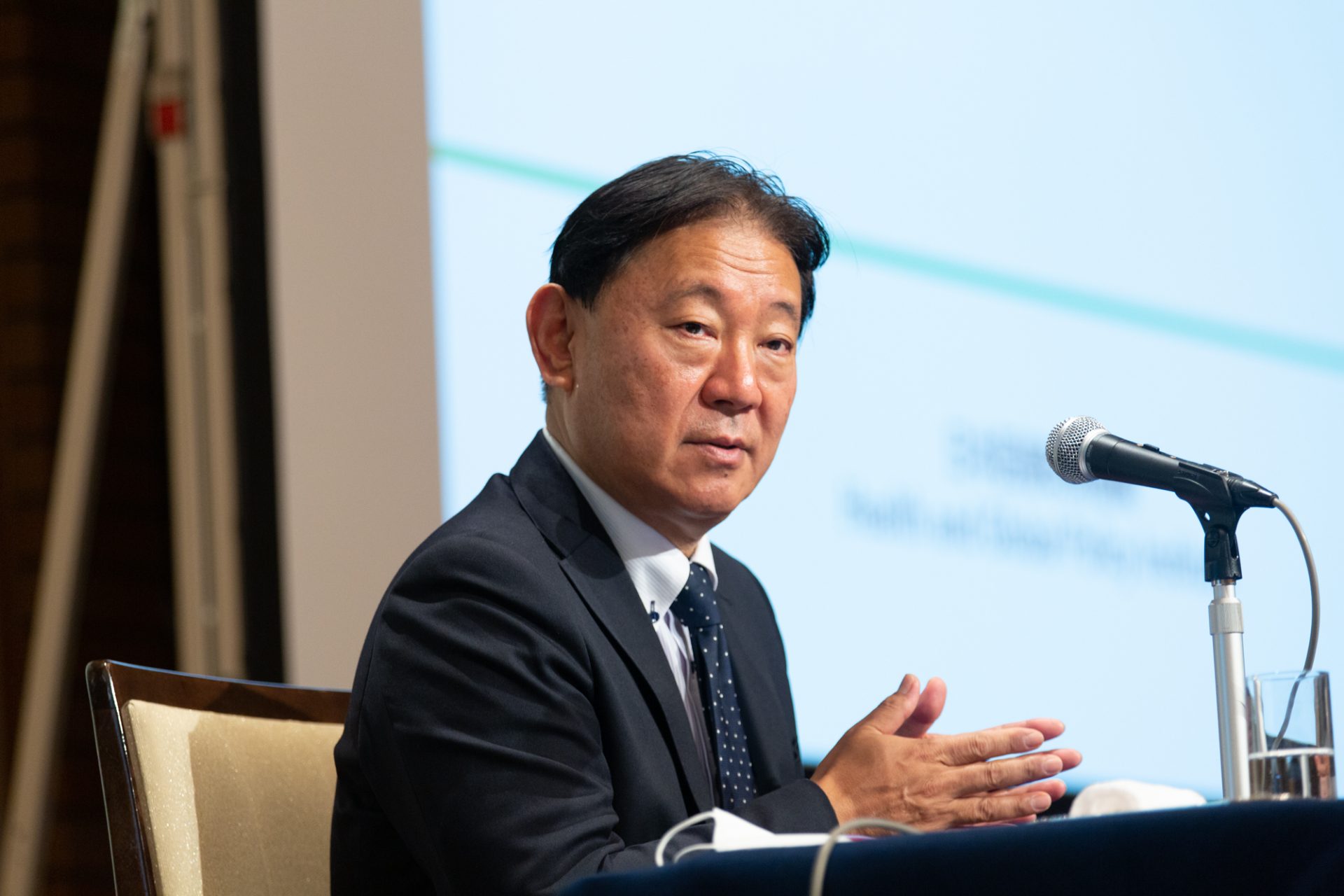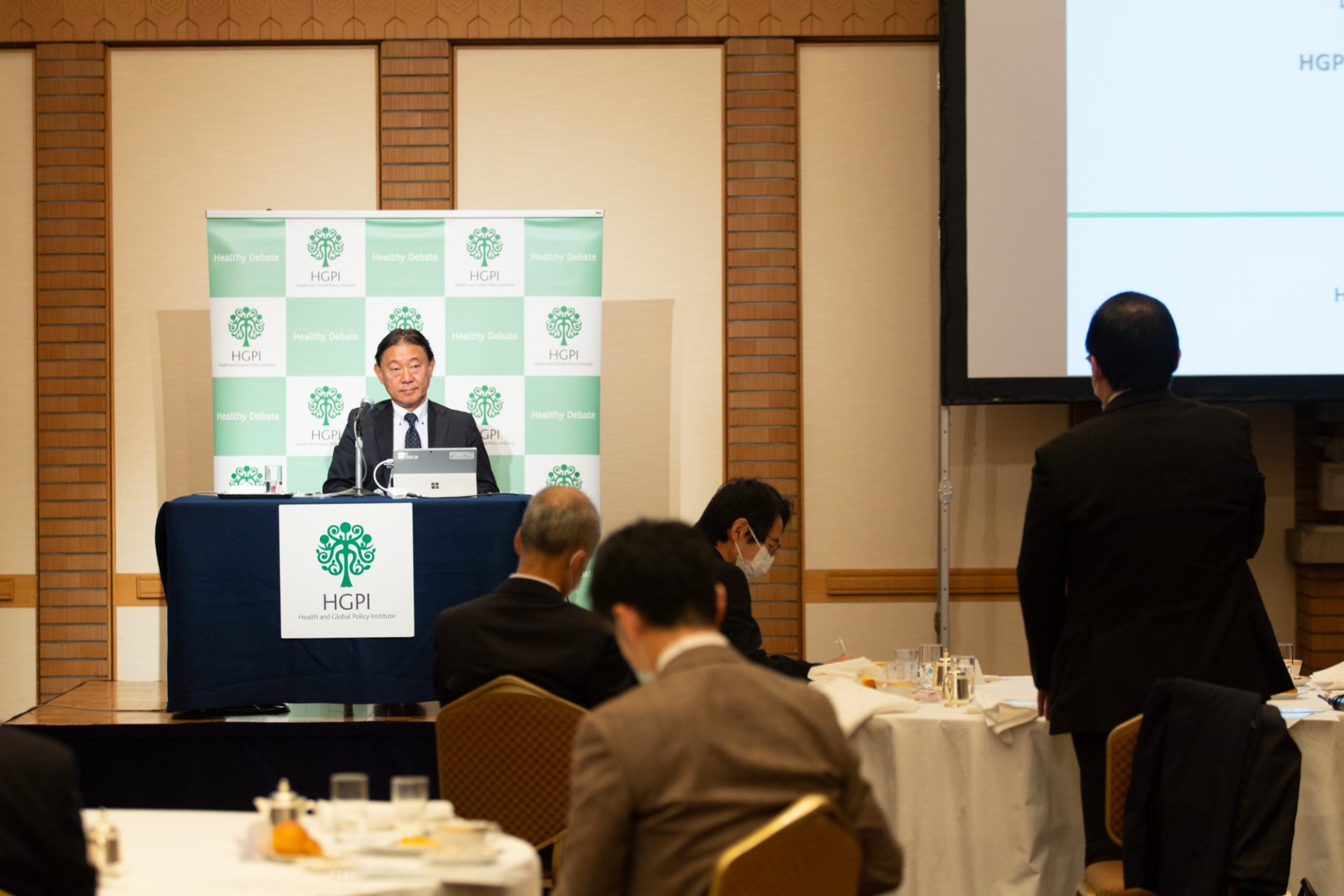[Event Report] The 46th Special Breakfast Meeting – Looking Back on 1,124 Days as Chief Medical and Global Health Officer – The Past and Future of the Healthcare System (December 11, 2020)
date : 2/3/2021
Tags: AMR, Special Breakfast Meeting
![[Event Report] The 46th Special Breakfast Meeting – Looking Back on 1,124 Days as Chief Medical and Global Health Officer – The Past and Future of the Healthcare System (December 11, 2020)](https://hgpi.org/en/wp-content/uploads/sites/2/sbm-46-1-top.jpg)
For the 46th Special Breakfast Meeting, we hosted Ministry of Health, Labour and Welfare (MHLW) Advisor and Former Chief Medical and Global Health Officer Dr. Yasuhiro Suzuki. While looking back on the 1,124 days he spent as Chief Medical and Global Health Officer, Dr. Suzuki gave a lecture on the ongoing response to the Coronavirus Disease 2019 (COVID-19) pandemic and shared his perspective on the ideal way to structure the healthcare system in the future.
To prevent the spread of COVID-19 infections, the venue was thoroughly disinfected, the flow of people within the venue was controlled, and guest capacity was limited.
Key points of the lecture
- The position of Chief Medical and Global Health Officer was established in 2017 to energize global health and to strengthen collaboration within the ministry, with other ministries, and with the private sector.
- Although Japan’s population is aging at a higher rate than other countries, Japan was able to keep COVID-19 deaths low thanks to stringent efforts from people at healthcare and long-term care facilities and to the orderly nature of Japanese people.
- When considering the future healthcare provision system in terms of the lessons learned during the COVID-19 pandemic, topics that will require discussion include preparations that must be made before emergencies and how to use reserve resources, communicate risk to the public, and allocate resources that are scarce during emergencies.
- While COVID-19 presents us with significant risks, this pandemic should be taken as an opportunity to make Japan’s healthcare system and economy more resilient, and the lessons we have learned should be reflected when designing future systems.
■ The background of the establishment of Chief Medical and Global Health Officer
To begin, I would like to reflect on my role as the first Chief Medical and Global Health Officer. The position of Chief Medical and Global Health Officer was established in July 2017 to fill a central role in promoting important measures within the healthcare sector.
There were two reasons for the establishment of the position of Chief Medical and Global Health Officer. First, the Chief Medical and Global Health Officer was expected to serve as a central coordinator for collaboration within the ministry, with other ministries, and with the private sector. An example of a field they in which they might “strengthen cooperation within the MHLW” would be pharmaceutical development. This is because within the MHLW, the Health Sciences Division manages R&D, the Pharmaceutical Safety and Environmental Health Bureau handles approval, the Insurance Bureau Central Social Insurance Medical Council (Chuikyo) is responsible for pricing, and the Medical Affairs Bureau manages industrial policy. The vision of each department must be shared within the ministry so that each one can conduct its various duties, so the Chief Medical and Global Health Officer serves to act as a unifier across these fields. The Chief Medical and Global Health Officer is also expected to “reinforce cooperation with other ministries and agencies as a representative of the MHLW.” For example, the MHLW is involved in pre- and post-graduate education and medical research at university medical schools in cooperation with the Ministry of Education, Culture, Sports, Science and Technology (MEXT). It also collaborates with the Ministry of Economy, Trade and Industry (METI) on industrial policies such as those for medical devices and health management. It can be difficult for the MHLW to advance policies in these fields on its own, so I believe it will be necessary to further strengthen cooperation.
While cooperation within and among ministries is important, another important duty of the Chief Medical and Global Health Officer is strengthening public-private partnerships (PPPs) among stakeholders that, in recent years, could said to be “in the same boat.” This is a critical measure for future medical policy. As an example, we might consider how approval reviews are conducted for medical devices that use Artificial Intelligence (AI) technology. The current approval process for medical devices does not allow for specification changes to be made after an application is submitted. However, AI technology is constantly evolving, and the current approval system is unable to reflect that evolution. In the future, it may be necessary to change the approval system so that the algorithms that are used in medical devices that utilize AI technology are evaluated directly. Handling high-priced pharmaceuticals is another issue that requires public-private collaboration. One potential method of solving this issue would be to lower the prices of all pharmaceuticals with high prices and sales volumes, but I believe that public-private cooperation should focus on reducing the costs and risks associated with Post Marketing Surveillance (PMS) and clinical trials. The Medical Information Database NETwork (MID-NET) developed by the Pharmaceuticals and Medical Devices Agency (PMDA) is mainly intended for use in PMS, and there are many ways it could be improved. For example, companies using MID-NET are faced with many security restrictions, so MID-NET’s design could be updated to meet modern data processing standards. I also have high expectations for the disease registry to be utilized more thoroughly in clinical trials. In conventional clinical trials, researchers must recruit one cohort that has been treated with a pharmaceutical and one that has not (a control group) for each trial. However, proper utilization of the disease registry will allow researchers to extract information on people who meet the characteristics of those who would form a control group for comparison. Although the fields in which research can be conducted in this manner are still limited, if repeated use of this method can lower costs, it would benefit both the pharmaceutical industry and the public.
The second reason the position of Chief Medical and Global Health Officer was established is so they can “energize global health as a diplomatic tool.” When I visited the Amazon region of South America, I witnessed cases in which the U.S. Peace Corps (the equivalent of Japan Overseas Cooperation Volunteers (JOCV)) administered large doses of antibiotics to combat the high infant mortality rate. While they successfully lowered the infant mortality rate, their efforts resulted in a rapid increase in the population. That, in turn, led to an increase in the number of people unable to go to school or find work as well as in the number of people living in slums. This made me realize that while it is extremely important to save the lives of the people in front of us, we must also consider the impact of our actions have on society. After World War II, Japan has had considerable restrictions on foreign military aid and therefore must make proactive use of medical and health aid as a diplomatic tool. Through our experiences during the COVID-19 pandemic, we reaffirmed that our own security cannot be maintained if it is not maintained in every country and region. In the future, when the Tokyo Olympics are held and international trade and travel resume, infectious diseases will once again flow into Japan from abroad. While it will be important to further improve border measures, to reduce the burden placed on border control during pandemics, I think it will also be important to support measures against infectious diseases in other countries during normal time, which will lead to Japan’s future benefit.
■ The effects of COVID-19 on Japan’s healthcare provision system
First, after the state of emergency was declared in April, performance indicators among healthcare institutions deteriorated significantly. There was a particularly large drop in May, when revenues from less-urgent medical services such as medical checkups and physical examinations fell by more than 60% compared to May of the previous year. Use of both outpatient and inpatient services declined in May, but outpatient services have been recovering gradually since June. Every field in inpatient care is currently facing an unprecedented burden in terms of patient health management, PCR testing, and the disinfection of hospital rooms as a countermeasure against COVID-19. As a result, the turnover rate has fallen by more than 5%. Taking a closer look at outpatient care visits by discipline, there were particularly pronounced declines in otolaryngology, pediatrics, and orthopedics. The decline in pediatric visits was not only due to the fear of infection, but also due to the decrease in influenza, rotavirus, measles, and rubella infections that occurred as a result of broader use of online medical services and the more thorough use of masks and other infection control measures compared to previous years. In addition to differences among disciplines, there were also differences in measures taken at healthcare institutions, such as those to control visitor flow lanes and to avoid crowding. These are thought to have made a difference in the recovery of the number of medical examinations. Although COVID-19 has resulted in more debate on the pros and cons of online medical care, complete care cannot be provided through online medical care alone, so we must consider how to best combine online and in-person medical care. Broader use of electronic prescriptions will also make it possible to reorganize pharmacies into those that serve as warehouses and those that serve as community pharmacies that people visit in-person.
■ Topics to consider in light of the COVID-19 pandemic
・Establishing core and surge capacities
Thinking back on the past two decades or so, we were faced with five deadly pandemics that occurred on a global scale: Avian Flu (H5) in 1997, SARS in 2003, H1 in 2009, MARS in 2012, and COVID-19 in 2020. In short, we need to design healthcare administration systems and make social and economic preparations based on the assumption that global pandemics occur every four to five years. It is important we consider what level of core capacity must be maintained during normal times and what surge capacity we will need for emergencies. One example of surge capacity is Reserve Self-Defense Force (SDF) officials, who are provided with fixed salaries to undergo training every year and can voluntarily serve as Japan Self-Defense Force (JSDF) personnel during emergencies. I think we must apply that concept to medical care and establish a system that allows us to respond to both normal and emergency situations, such as by providing regular, voluntary training programs for so-called “latent nurses” who are said to account for one-third of all qualified nurses. They would be able to provide assistance at public health centers and outpatient clinics when necessary.
・Upholding individuals’ rights
Looking at COVID-19 infection rates, we find that there have been fewer cases in East Asia than in Europe and the U.S., and that among East Asian countries, Singapore, South Korea, and Taiwan have had the fewest infections. In these three countries, Global Positioning Systems (GPS) are under government control. Many younger people who are infected with COVID-19 are asymptomatic or only experience mild symptoms, so they do not require intensive treatment in hospitals and can recover at home. One measure that helped prevent infections in these countries was that alarms would sound if infected people stepped outside of a 10-meter radius from their homes during the two-week home recovery period. Those that left their homes three or more times were fined. Meanwhile, in Japan, public health nurses have been contacting people’s homes to check if they are in. Not only do the three aforementioned countries have knowledge from past pandemics like SARS and MARS, all three of them also have different experiences and situations than Japan, such as tense relations with neighboring countries. I believe that discussions must be held in Japan based on lessons learned from this pandemic, such as how to handle GPS information during emergencies.
・Risk communication
Looking back on Japan’s COVID-19 response, we cannot say that the Government and administration communicated risk in a sufficient manner. When there are no vaccines or established treatments like with COVID-19, preventing the spread of infections requires that information concerning risk is accurately communicated to change the behavior of the public. To prepare for future pandemics, methods of communicating risk must be verified and methodologies must be established.
・Discussions on allocating scarce resources
I believe that we must also discuss how to best allocate limited medical resources during pandemics such as this one. For example, it would be ideal if prefectures were able to secure a care bed for each patient, but in reality, doing so is difficult. The number of Extracorporeal Membrane Oxygenation (ECMO) machines is also limited, so those working in the field must make decisions concerning who can use them on a daily basis. To be ready for situations like these, we have to face the question of “Who should be prioritized?”
・The dilemma facing supply chains
The COVID-19 pandemic placed the supplies of masks and other medical equipment at risk. Economic rationality states that we should concentrate on procuring supplies from the sources that provide the highest quality for the lowest price. However, in terms of crisis management, it is highly risky to depend on supply chains in that manner. To prepare for future pandemics, we must take measures from multiple approaches, such as stockpiling (in quantities great enough to avoid any problems even if exports stop for three months), diversifying the countries and regions from which supplies are procured, and providing subsidies for domestic production.
■ Situations surrounding COVID-19 abroad
I would also like to touch upon situations surrounding COVID-19 abroad. There are differences in the number of excess deaths among European and American countries. Because there are places without significant differences in infection rates among countries located in the same regions, I find it likely that the number of excess deaths has been affected by factors other than the infection rate.
In general, we have seen low mortality rates among people in their 20s to 60s, and that people in this age range have been spreading COVID-19 through their everyday activities. In particular, those that are serving in healthcare and long-term care institutions are spreading COVID-19 among elderly people. Although Japan has a very high population aging rate by international standards, compared to countries in Africa and Asia with relatively low population aging rates, the mortality rate in Japan has been average. It is likely that this occurred because, in accordance with an early request from the Bureau of Health and Welfare for the Elderly, long-term care homes implemented strict measures to ban visitors, reduce contact with outside professionals, and prohibit staff from eating or drinking outside of the facility premises.
On the topic of COVID-19 countermeasures, there is one line of thinking that says the number of deaths can be controlled if the number of infections is kept low, and one that says the number of deaths can be kept low if extra care bed capacity is used to treat infected people age 60 or over. Both infections and deaths were high in Italy and Spain, but Germany has a high number of infections and very few deaths. This is because Italy and Spain originally had a limited number of care beds, while Germany is the only country in Europe with many care beds. I believe it was Germany’s utilization of its extra care bed capacity during this pandemic that there were fewer deaths there, and that Japan should aim to implement the same model.
■ Points to emphasize in healthcare policy moving forward
To conclude, I would like to share various points that I believe should be emphasized in healthcare policy in the future.
・The creation of outcome-based payment schemes
Currently, payments are based on services provided, such as testing, but in the future, we should consider transitioning to a system in which payments are based on treatment outcomes. I have high expectations that basing payments on treatment effectiveness and extending coverage beyond pharmaceutical treatment to include services such as exercise and nutritional guidance will result in more effective and efficient use of medical resources.
・Cloud-based electronic medical records
Currently, electronic medical records are stored in separate systems at each institution without communication among them. Providing convenient data access through cloud-based electronic medical records will enable the monitoring of patient data during emergencies. It will also allow other healthcare institutions to access accurate patient information such as allergy information. However, it may be necessary to revise and improve the Act on the Protection of Personal Information and other related laws related to various qualifications, which is a topic to be discussed in the future.
・Advances in genomic medicine for cancer treatment
It is said among lifestyle-related diseases such as cancer, stroke, and heart disease, cancer has the most genetic risk factors. Since causative genes differ among races, however, Japan must promote domestic research. Expanding genetic analysis will make it possible to select the most appropriate treatments and medications for each person, which will provide great benefits in terms of both medical resource use and patient quality of life. To develop genomic medicine, the existing pharmaceutical approval system must be streamlined and improved and a business climate that promotes domestic R&D on biotechnology products must be created.
・ Combatting Antimicrobial Resistance (AMR)
A study from the UK predicted that in 2050, the number of deaths caused by antimicrobial-resistant organisms will exceed the number of deaths from cancer. Since it takes five to ten years to develop a new antibiotic, development must start now so that we do not regret it in the future. This is especially true in Japan, which is characterized by the use of newer generations of antibiotics. Using newer antibiotics makes it more likely that antimicrobial-resistant strains for which there are no available antibiotics will appear. The use of antibiotics on animals, including those to promote growth, accounts for 58% of total use In Japan. This situation must be improved.
■ In conclusion
The working-age population in Japan is currently shrinking. For the social security system, this means fewer people paying taxes and insurance premiums. On top of that, we are experiencing a pandemic every four to five years, so we must build a social security system with that in mind. It will be difficult for the public health insurance system to continue paying out as much as it has up until now, so reforms focusing on prioritization are essential. Japan continues to have an excessive number of care beds even by international standards, so we must also promote measures to consolidate them effectively. As demonstrated during the COVID-19 pandemic, most people in Japan are able to maintain order without severe penalties in place, so I hope that future systems are designed with the strengths of Japanese culture in mind.
Healthcare and long-term care are labor-intensive industries, so we need to effectively split tasks between those that must be handled by people and those in which people can be replaced by technology. It has been reported that 40% of the current workforce will lose their jobs because of advances in AI, but it is likely that those job losses will be offset by the decrease in the number of workers as Japan’s working-age population continues to shrink.
When President John F. Kennedy’s cabinet members were exhausted from negotiations during the 1962 Cuban Missile Crisis, he encouraged them by saying, “When written in Chinese, the word ‘crisis’ is composed of two characters. One represents danger and the other represents opportunity.” In the face of danger, he saw an opportunity to open negotiations with the Soviet Union while building friendly relations with Cuba. COVID-19 also presents us with a great deal of danger, but I hope that we can use this as an opportunity to make Japan’s health care and economic systems more resilient.
A lively exchange of opinions on the ideal structure of an outcome-based health insurance system and future COVID-19 measures took place during the question and answer session with the audience after the lecture.
(Photographed by: Kazunori Izawa)
■Profile
Dr. SUZUKI Yasuhiro (Advisor and Former Chief Medical and Global Health Officer, Ministry of Health, Labour and Welfare)
Dr. Suzuki was born in 1959. He graduated from School of Medicine, Keio University (MD) in 1984 and trained as neurologist. He received PhD for public health from Keio University in 1996 and two Master’s degrees from the Harvard School of Public Health (MPH in 1989 & MSc in 1990).
Dr. Suzuki has a professional career at the Ministry of Health, Labour and Welfare (MHLW), Japan for 30 years covering infectious diseases, mental health, environmental health, food safety, international health, ageing & health, and health research policy. He also worked for the World Health Organization as Executive Director for Social Change & Mental Health, later for Health Technology and Pharmaceuticals (covering vaccines, immunization and biologicals) from 1998 to 2002.
He previously served as Vice-Minister for Health, Chief Medical & Global Health Officer at the MHLW from July 2017 to August 2020.
Top Research & Recommendations Posts
- [Policy Recommendations] Achieving a Sustainable Society of Health and Longevity Through the Integration of Environment and Healthcare-Incorporating a Planetary Health Perspective into the 3rd Phase of The Healthcare Policy-(December 20, 2024)
- [Research Report] Building a Mental Health Program for Children and Measuring its Effectiveness (June 16, 2022)
- [Policy Recommendations] Integrating Climate and Health for a Sustainable Society: Incorporating a Planetary Health Perspective into Nationally Determined Contributions (NDCs)(December 9, 2024)
- [Policy Recommendations] Policy Recommendations on Strengthening CKD Strategies for Workers: The Importance of Providing Early Detection, Intervention, and Support Through Screenings and Medical Visits (October 28, 2024)
- [Research Report] The 2023 Public Opinion Survey on Satisfaction in Healthcare in Japan and Healthcare Applications of Generative AI (January 11, 2024)
- [Policy Recommendations] Developing a National Health and Climate Strategy for Japan (June 26, 2024)
- [Event Report] Planetary Health Expert Meeting Aiming for Sustainable Healthcare: Learning from the Impact of Environmental Pollution and Medical Waste During the Pandemic (February 16, 2024)
- [Policy Recommendations] Obesity Control Promotion Project 2023 “The Next Steps for Engaging and Cooperating with Patients, Citizens, and Communities for Implements of Obesity Control Measurements” (April 8, 2024)
- [Announcement] A Turning Point Towards Building Green Healthcare Systems (June 5, 2024)
- [Research Report] Survey of Japanese Physicians Regarding Climate Change and Health (December 3, 2023)
Featured Posts
-
2024-11-25
[Registration Open] (Webinar) The 130th HGPI Seminar “Marking a Decade of the Act on Medical Care for Patients With Intractable Diseases: Connecting Intractable Diseases and Society From the Perspective of a Media Professional and Family Member” (January 28, 2025)
![[Registration Open] (Webinar) The 130th HGPI Seminar “Marking a Decade of the Act on Medical Care for Patients With Intractable Diseases: Connecting Intractable Diseases and Society From the Perspective of a Media Professional and Family Member” (January 28, 2025)](https://hgpi.org/en/wp-content/uploads/sites/2/hs130-top_JPNENG-1.png)
-
2024-12-18
[Policy Recommendations] Policy Recommendations on Strengthening CKD Strategies for Workers: The Importance of Providing Early Detection, Intervention, and Support Through Screenings and Medical Visits (October 28, 2024)
![[Policy Recommendations] Policy Recommendations on Strengthening CKD Strategies for Workers: The Importance of Providing Early Detection, Intervention, and Support Through Screenings and Medical Visits (October 28, 2024)](https://hgpi.org/en/wp-content/uploads/sites/2/HGPI_20241023_FY2024CKD_eyecatch.jpg)
-
2024-12-20
[Policy Recommendations] Achieving a Sustainable Society of Health and Longevity Through the Integration of Environment and Healthcare-Incorporating a Planetary Health Perspective into the 3rd Phase of The Healthcare Policy-(December 20, 2024)
![[Policy Recommendations] Achieving a Sustainable Society of Health and Longevity Through the Integration of Environment and Healthcare-Incorporating a Planetary Health Perspective into the 3rd Phase of The Healthcare Policy-(December 20, 2024)](https://hgpi.org/en/wp-content/uploads/sites/2/e8a714648913193b03d5b6ede38c161e.png)
-
2024-12-25
[Registration Open] (Hybrid Format) Expert Meeting “Innovations Required to Achieve Precision Psychiatry” (January 22, 2025)
![[Registration Open] (Hybrid Format) Expert Meeting “Innovations Required to Achieve Precision Psychiatry” (January 22, 2025)](https://hgpi.org/en/wp-content/uploads/sites/2/mh-20250122-topr-1.png)
-
2024-12-27
[Activity Report] Second UN General Assembly High-Level Meeting on AMR (September 26, 2024)
![[Activity Report] Second UN General Assembly High-Level Meeting on AMR (September 26, 2024)](https://hgpi.org/en/wp-content/uploads/sites/2/4ED86AF7-49DE-465D-B59D-843B4F3C6102_1_201_a-scaled-1.jpeg)






